Performance Review | AIR Modern Music Ensemble – Six Works Weave an Auditory Poem Across Time and Space
At 15:00 on May 20th, the AIR Modern Music Ensemble converged at the Central Conservatory of Music Concert Hall to perform six modern works. From exploring the limits of sound with innovative techniques to multi-sensory surreal experiences, this musical feast was not only a deep dive into the possibilities of sound but also an aesthetic revolution breaking sensory shackles.
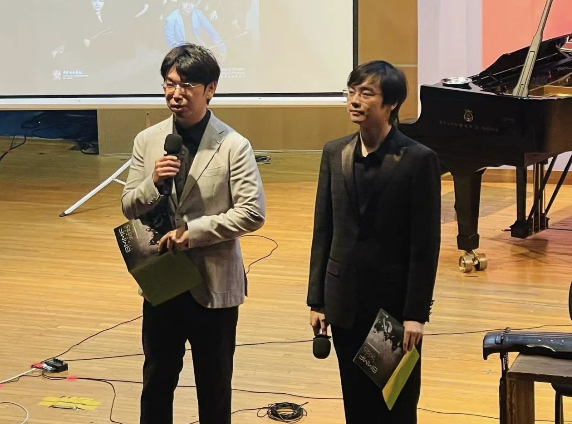
As instrumental timbres, electronic soundscapes, and visual imagery intertwined and resonated, the artistic DNA of tradition and modernity, East and West, collided and merged. Between deconstruction and reconstruction, the concert opened a door for the audience to a realm of infinite expression.
Le Yan's 《intro》 and 《Monolith·II》 opened the concert with the grandeur of splashed-ink landscape paintings. 《Monolith II》 is the second piece in the "Monolith" series, written for solo instrument and electronic music. The composer initially created "Monolith" due to an innovative instrumentation; the timbre of the Guqin, in the composer's mind, resembles Zhang Daqian's splashed-ink landscapes, where the artist freely splashes large areas of ink onto Xuan paper and then improvises based on the resulting shapes. Each musical phrase in this piece is like a brushstroke upon that splashed-ink landscape for the composer. 《intro》 was a later-composed introduction for "Monolith." In this piece, the Pipa and Sheng parts were not positioned on stage but were seated separately on either side, creating a more diffuse sound field, where the audience and the sound coexisted, each like a stroke in the splashed-ink painting.
In 《Monolith II》, to construct a rugged "monolith" imagery, the composer intentionally avoided traditional sound forms like "melody and accompaniment." At the same time, the composer precisely used spectral delay effects, a technique that repeats different frequency bands of an instrument at different times. Applied to the Guqin, this technique continuously expanded the originally fleeting harmonics of the Guqin solo, creating a ripple-like effect, to some extent mimicking the state of "splashed color" (泼彩). The piece constantly switched between the "splashed color" effect and traditional Guqin techniques, eventually coexisting and forming a complete entity.

Huang Wen's 《宴之游荧》 (Fireflies at a Banquet's Stroll) appeared as the second piece. Erhu, Pipa, Sheng, piano, and percussion intertwined and collided, as if lighting up countless fireflies under the night sky. The timbre of the glockenspiel floated like silken threads above the Pipa and Erhu parts, resembling scattered fireflies twinkling with faint light along dark paths and by grassy edges.
In an instant, the resonant boom of the bass drum and the clang of cymbals, like a heavy hammer, thoroughly "sounded out" the density of the night. Against this deepening night, the piano, with its drifting fragmented motifs, resembled millions of fireflies clustering together, flitting up and down, their glow becoming ever brighter. The Sheng's timbre became ethereal, vaguely outlining the undulating silhouettes of mountains under the night sky. The Erhu's continuous melody, like a winding path, guided the audience's thoughts, extending mysteriously into the depths of the mountains.
Gradually, the music quieted, and the dark sky silenced the world. The celesta and bass drum, in interspersed passages, symbolized the burning and blooming of starlight and fireflies in the darkness, taking us through the mountains, capturing those flickering glimmers in the dark.
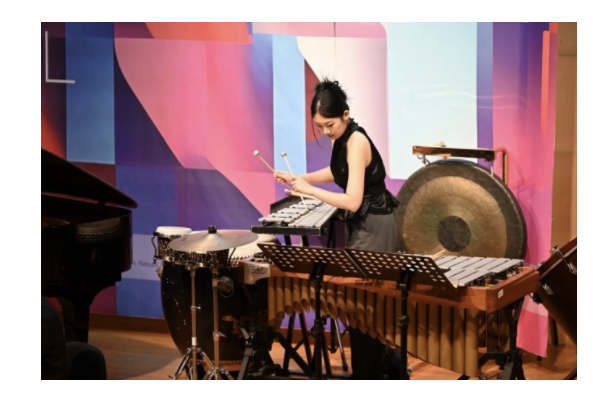
Lin Muxuan's 《透过矽孔雀石玻璃》 (Through Chrysocolla Glass) is a hyper-immersive work that uses electronic music and video to expand the concert's sound field. The composer attempts to construct a multi-sensory experience, sonically presented, using elements like the pervasive intimate surrealism of the present moment, changes in outdoor temperature, and the distance and orientation between people and others, nature, or machines.
The entire piece is like a camera's frame, framing a memory of a summer beach in the audience's eyes. In people's minds, memory fragments can also be edited and reconstructed in the brain. In the first half, the sharp timbres of the bass flute and Guzheng represent concrete memories. In the second half, the flute and Guzheng fall silent, leaving fragmented electronic background sounds attempting to restore the beach's soundscape, but only flashing back to the ears in a hazy way. The video component consists of still photos – some from the protagonist's first-person perspective – which briefly appear before quickly passing; others are of the protagonist themselves – these are the photos that can be preserved, lingering the longest. Our memories are composed of these sounds and images.
Through the dialogue between electronic media and traditional instruments, the work achieves a creative expansion of spatial dimensions. The ambient sound field created by electronic music breaks physical boundaries, transforming the concert hall into a virtual beach; alternating still frames and dynamic images in the video construct an overlapping effect of multi-dimensional time and space. Precisely because of this, in this piece, the audience, through these fragmented memories, feels as if they have truly arrived at that seaside...
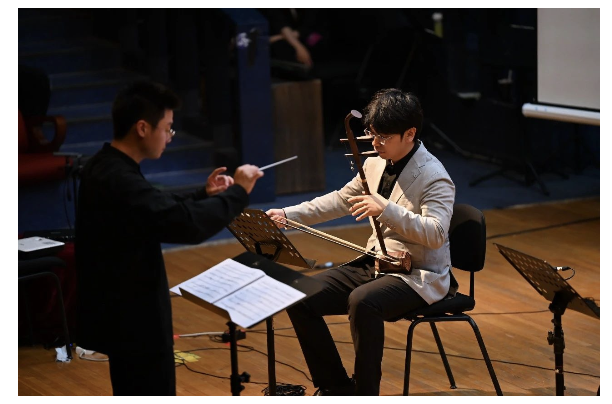
Wen Ziyang's 《野望》 (Wild Gaze), led by the Erhu and featuring five folk musicians, opened the second half. The composer fused poetic philosophy into the sonic structure, constructing a musical narrative space rich in Eastern aesthetic meaning. "Silent Mountains" (默山) was inspired by Yu Guangzhong's "Distant mountains are silent, string sounds as cold as frost"; "Dark Night" (暗夜) was depicted from Hai Zi's "Night rises from the earth, obscuring the bright sky"; "Mysterious Strings" (幽弦) derived from Dante's "The music of the lyre is distant, like the song of the River Styx."
A continuous tremolo and extended lines from the Erhu in its highest register, simulating the shriek of the north wind, ran through the entire piece, clashing with the Pipa's dense strumming and the Sheng's resonance. This was complemented by low-frequency rumbles and metallic tearing sounds from the percussion, shaping the chaos and oppression of a wilderness shrouded in night, constructing a vast, distant wild landscape. The entire work, through the ultimate development of the Huqin's characteristics – "the inner string robust, the outer string clear and bright" – combined with the timbral dialogue of multiple instruments, achieved an artistic sublimation from a visual wilderness to a desolate landscape of the soul, showcasing the pioneering nature and profound cultural heritage of contemporary folk music composition.
Jin Zhuocheng's 《异乡人》 (The Sojourner) is dedicated to all wanderers who, for various reasons, can no longer return home. Using Yangqin, Erhu, Guqin, and piano as media, it transforms the sorrow of countless sojourners unable to return home into leaping musical notes. When distorted melodies and the microtonally tuned Yangqin solo intertwine, it's like the wandering thoughts of a sojourner flowing through time, gradually blurring, shattering, and dissipating into the distance.
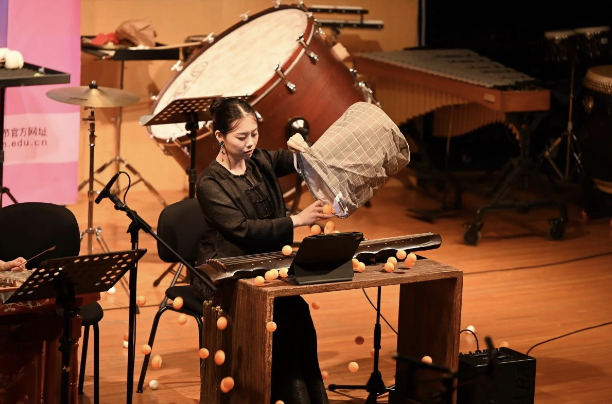
The most unexpected moment in the piece was when, during the performance, the Yangqin player suddenly lifted a cloth bag full of ping pong balls and poured them out. The bouncing balls struck the Yangqin strings, further accentuating the timbre of the already microtonally tuned instrument. Soon after, the piano and Guqin repeated this process; when striking strings with ping pong balls on them, the balls would repeatedly bounce between the strings due to vibration. The resulting subtle, chaotic sounds rose and fell—drifting, free, unpredictable—much like the scattered thoughts of a sojourner. Each collision seemed to strike the heart, adding endless sorrow and desolation to the music, allowing one to deeply feel the unspeakable loneliness and grief in the wanderer's heart.
Carolyn Chen's 《与引力的关系》 (Relationship with Gravity), centered on "falling," transforms various collected stories and theories of gravity into interwoven static and dynamic audiovisual materials. The quartet, like four empathetic interlocutors, responds to this eternal force with a performance that combines standard playing and playfulness.
In the piece, the Erhu's continuous glissandi resemble the dynamic trajectory of falling objects; percussion, with varied rhythms, simulates different forms of falling outcomes—sometimes heavy, sometimes crisp—like different knockings of fate. The Guqin, with a deeper timbre, continues the Erhu's glissandi, a tangible representation of gravity in space. It infinitely prolongs the process of sound decay, as if narrating the long journey of all things from existence to annihilation under gravity's influence. In the background, a monologue narrating Newton's discovery of the law of universal gravitation echoes the music, emphasizing gravity's speed, irresistibility, and ubiquity. As the piece neared its end, the Erhu's pizzicato and the piano's high notes, like the ticking of time, allowed each part, under this "temporal gravity," to complete this ultimate narrative about gravity in its own unique way, leaving a lingering, thought-provoking resonance.
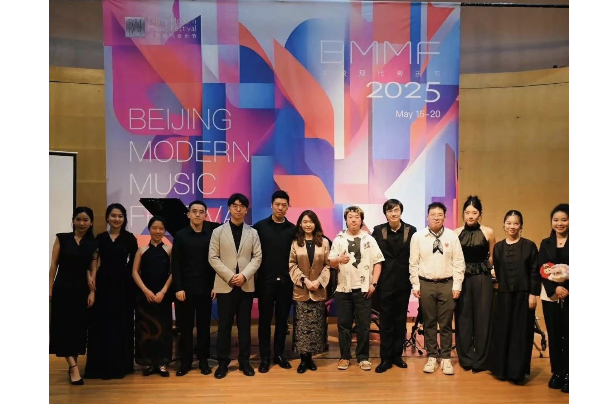
When the final note dissipated under the dome of the Central Conservatory of Music Concert Hall, this musical feast brought by the AIR Modern Music Ensemble had long transcended the boundaries of notes themselves. Each work was a synesthetic connection of tradition and modernity, East and West, auditory and visual. These sound experiments, spanning regions, media, and cultures, not only wove a tapestry of common human emotions but also allowed us to see the infinite possibilities of music as a universal language.
Executive Director | Guo Hai'ou
Executive Assistants | Zhang Shuhao, Yin Nan
Text by | Li Jiaxuan
Photography by | Zhang Yaxuan
